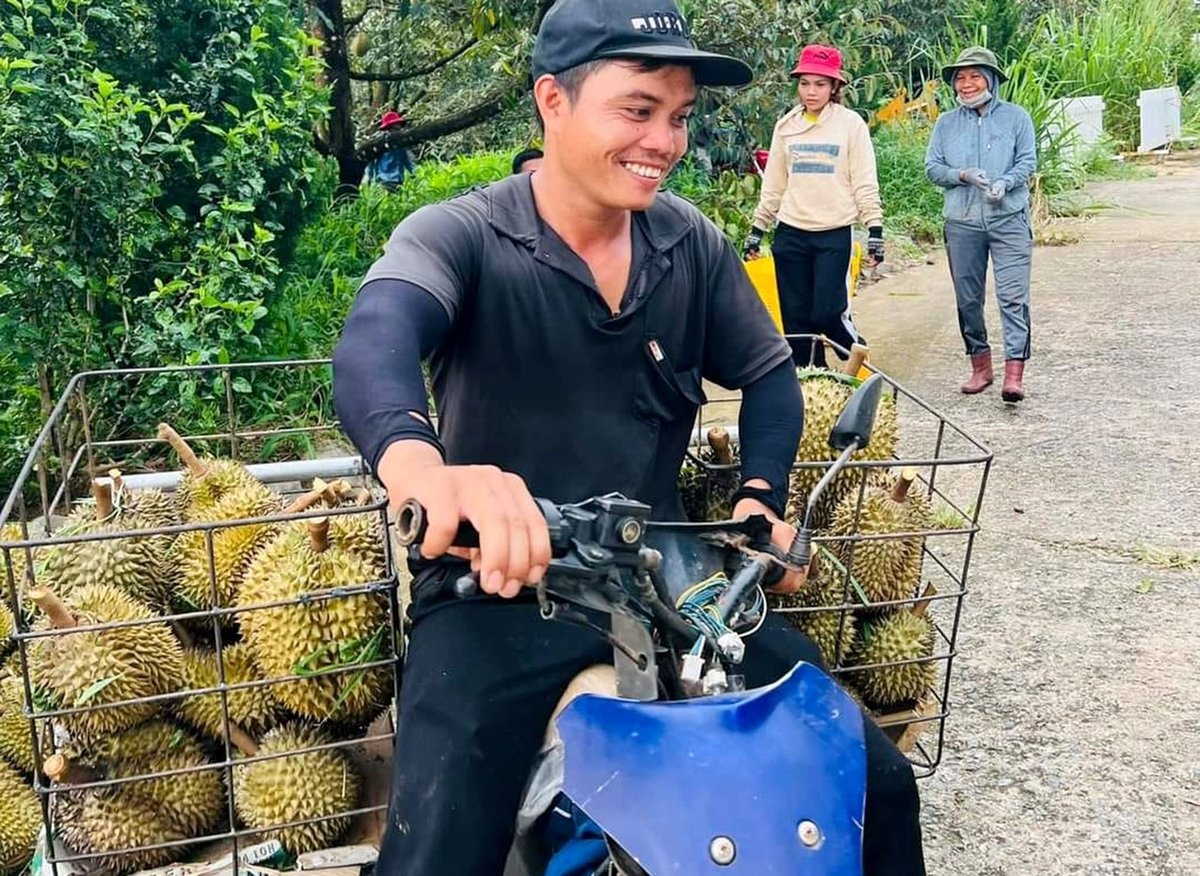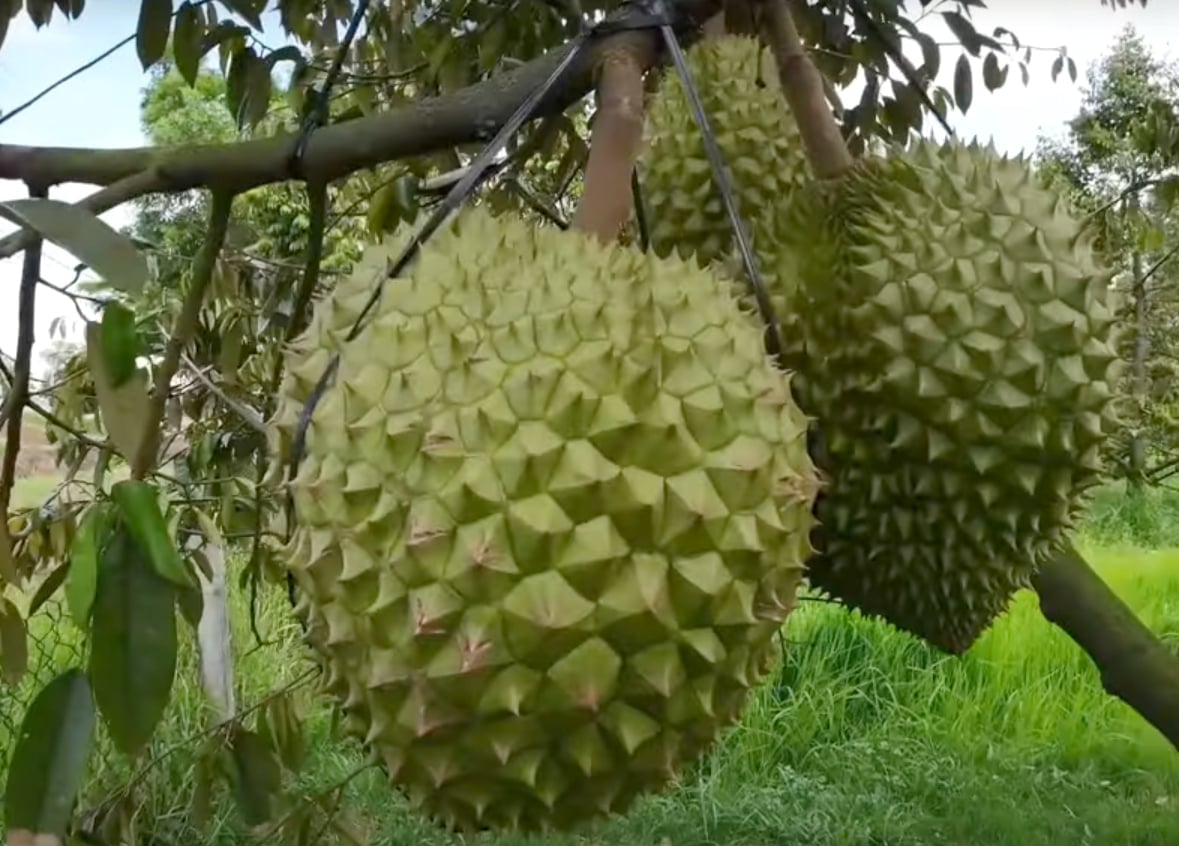October 26, 2025 | 15:31 GMT +7
October 26, 2025 | 15:31 GMT +7
Hotline: 0913.378.918
October 26, 2025 | 15:31 GMT +7
Hotline: 0913.378.918
Last June, Vietnam's fruit and vegetable exports reached their highest level since the beginning of the year. Data from the General Department of Vietnam Customs shows that the country's fruit and vegetable export turnover in June reached USD 807 million, an increase of 30.9% compared to May 2025 and 20.7% compared to June 2024.
The impressive breakthrough in Vietnam's fruit and vegetable exports in June 2025 was primarily due to the strong recovery of the durian sector.

Farmers transport newly harvested durians to collection points. Photo: Son Trang.
According to the Foreign Trade Agency (Ministry of Industry and Trade), durian exports have become vibrant again, not only to the Chinese market but also to Thailand. The supply of durians in Thailand was disrupted between growing regions, which increased demand from Thai traders for durian imports from Vietnam.
Currently, key durian growing regions in the Central Highlands and Southeast, where cadmium contamination rates are low, are in season. This has helped more durians meet export standards, thereby assisting in the recovery of Vietnam's durian exports.
Mr. Dang Phuc Nguyen, General Secretary of the Vietnam Fruit and Vegetable Association (Vinafruit), stated that a crucial factor is that durian exporting enterprises are not only checking the quality of products brought to their warehouses but are also proactively checking quality directly from the farms, tightening the durian procurement and packaging processes.
Consequently, recently, farms wanting to sell durians to businesses must proactively check for cadmium and have certification that they are free of this substance. When purchasing durians from these farms, businesses re-check for cadmium, which has helped reduce risks for exported durians.
According to Mr. Nguyen, in the first three months of the year, Vietnam's durian exports were consistently very low each month, with no month reaching USD 100 million. In April, durian exports only slightly increased to over USD 100 million. The low level of durian exports in the first four months of the year significantly reduced Vietnam's total fruit and vegetable export turnover.
By May, durian exports began to show signs of recovery, reaching USD 204 million. In June, they continued to increase sharply to over USD 300 million (nearly equal to the exports of the previous five months combined). It is estimated that in July, durian export turnover will reach approximately USD 350 million to USD 400 million. Thus, it is projected that in the first seven months of the year, durian exports will have exceeded USD 1 billion.

Vietnam's durian exports are recovering thanks to better cadmium control. Photo: Son Trang.
In addition to durians, many other products such as coconuts, passion fruit, and processed mangoes also saw positive export growth in June 2025. The strong rebound in fruit and vegetable exports in June helped to slow down the decline in exports for the first six months of the year compared to the same period last year.
Specifically, by the end of Q1, Vietnam's fruit and vegetable exports only reached US$1.2 billion, a decrease of 9.2% compared to the same period last year. However, by the end of June, the total fruit and vegetable export turnover reached US$3.1 billion, a decrease of 6.7% compared to the same period.
The Foreign Trade Agency noted that although Vietnam's fruit and vegetable exports in the first six months of 2025 decreased compared to the same period in 2024, exports in June showed positive signs for the entire fruit and vegetable sector. This indicates that adjustment and adaptation efforts have begun to take effect, opening up prospects for a recovery in fruit and vegetable exports in the second half of the year.
Also according to the Foreign Trade Agency, although China's fruit and vegetable imports decreased in the first half of the year, demand for these imports is expected to rebound in the second half of this year. Therefore, once issues related to quarantine and quality are resolved, especially for durians and other tropical fruits, China's fruit and vegetable imports could increase sharply again.
Seasonally, China's demand for fruit and vegetable imports typically increases during festive seasons and the Lunar New Year, creating opportunities for exporters. Notably, China is increasingly interested in processed fruit and vegetable products due to their convenience and added value. This is a trend that Vietnamese exporters need to grasp.
Translated by Linh Linh

(VAN) Building on its leading position, Ho Chi Minh City drives a green, digital, and creative wood industry toward global reach and its goal of joining the world’s top 100 most livable cities by 2045.
/2025/10/25/0325-1-nongnghiep-130321.jpg)
(VAN) The 2024–2025 crop year of Viet Nam's coffee industry has ended with record export turnover of USD 8.4 billion. Since the beginning of this year, exports have already surpassed USD 7 billion.

(VAN) Vietnam and Chile are seeing opportunities to deepen their agricultural cooperation, especially as both share a common vision of sustainable development and trade integration.

(VAN) Strong export growth across industries drives Phu Tho’s economic breakthrough and contributes to achieving overall growth goals.

(VAN) During the first 7 months of 2025, Russia boosted its share of Chinese poultry imports to a record 18%, up from 14% the previous year.

(VAN) By October, fruit and vegetable export turnover is estimated to exceed 7 billion USD. This marks the second consecutive year that the sector has surpassed this milestone.

(VAN) Mr. Hamish Marr, New Zealand’s Special Agricultural Trade Envoy, shares experience in developing sustainable, transparent, and value-added agricultural export chains.